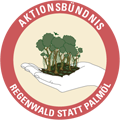Palm oil and its use

The fats from meat and fruit kernels of the oil palm (Elaeis guineensis) is currently the most widely used vegetable fat in the world. Compared with other fat and oil plants, palm oil provides by far the largest income per area. The recovered fat is also currently the cheapest on the world market.
A labelling requirement for food will come into force in Europe from December 2014. but to date, palm oil is generally only declared as "vegetable oil" or "vegetable fat" on most products.
The palm oil boom has been fuelled since the 1990s from Malaysia and Indonesia (about 85 percent of global production), and to some extent from South America and even in small quantities from Africa. Oil palm trees are mainly planted as a monoculture often in multiple 1,000 km² large plantations (for comparison: the total area of Berlin is about 890 km²) for which correspondingly large areas of rainforest were, and still are, cleared.
Palm oil is used for food and beverages of all kinds, also for detergents, wax candles, cosmetics and the like. About half of all these products are produced using palm oil or palm kernel oil. A further amount flows into "renewable energy".
Worldwide about 5% of "renewable energy" is derived from palm oil. In Germany, the share of palm oil as an energy source forms approximately (depending on the source) 30 - 50 percent of the total palm oil consumption in Germany. This concerns mainly block heating plants, but in smaller quantities also the admixture for vehicle fuels (biodiesel, bioethanol). The share of renewable energies in the transport sector is expected to increase further in Germany. In petrol, 5 percent bioethanol is now already considered the norm. In 2012 in the EU, the share of palm oil biodiesel stood at about 20 percent and is still rising.


